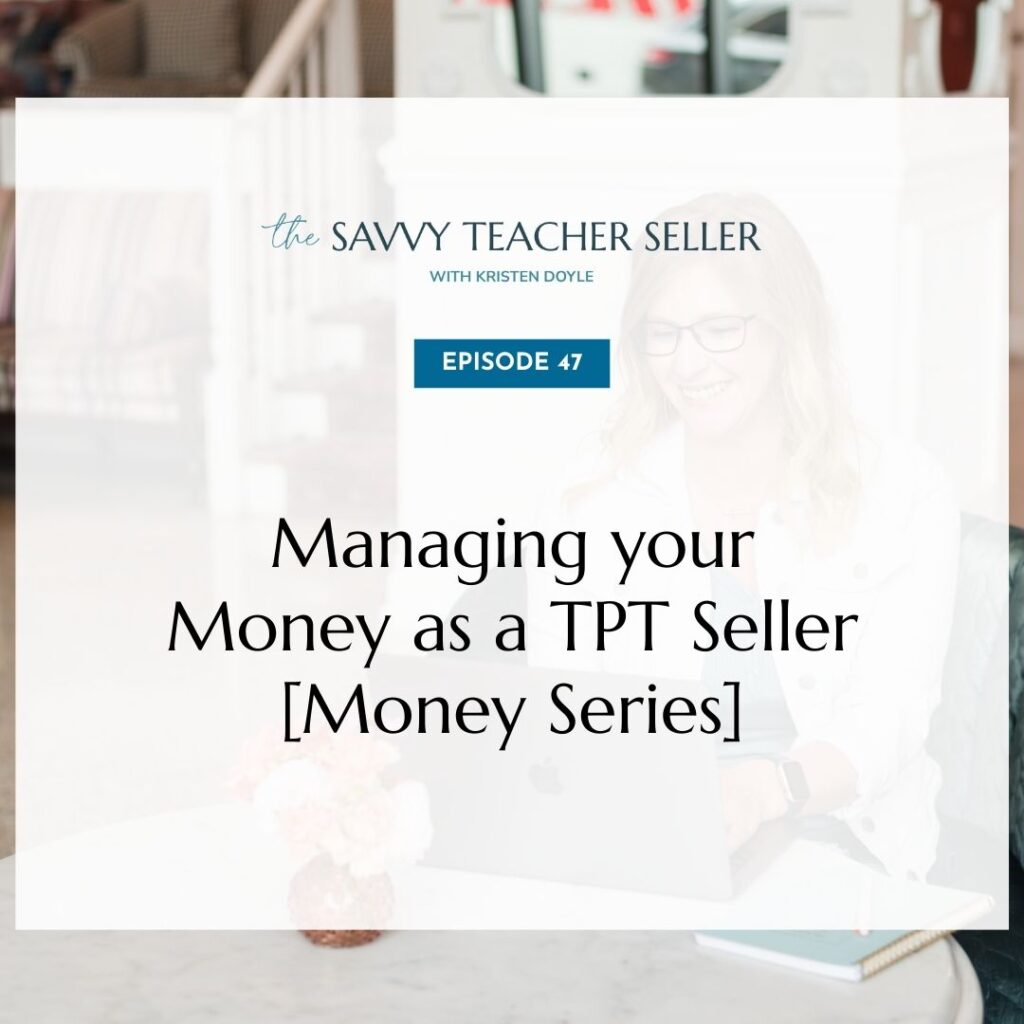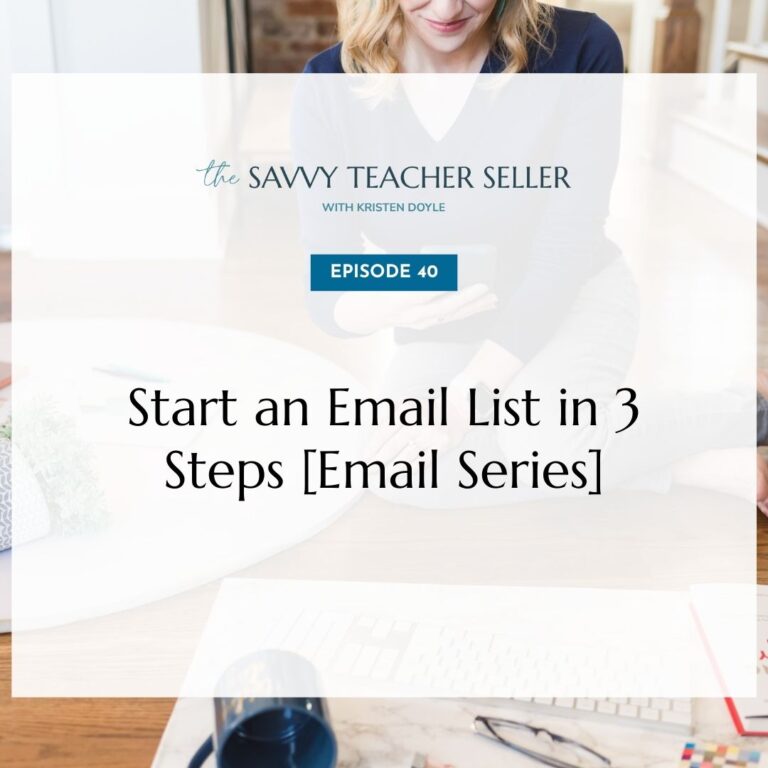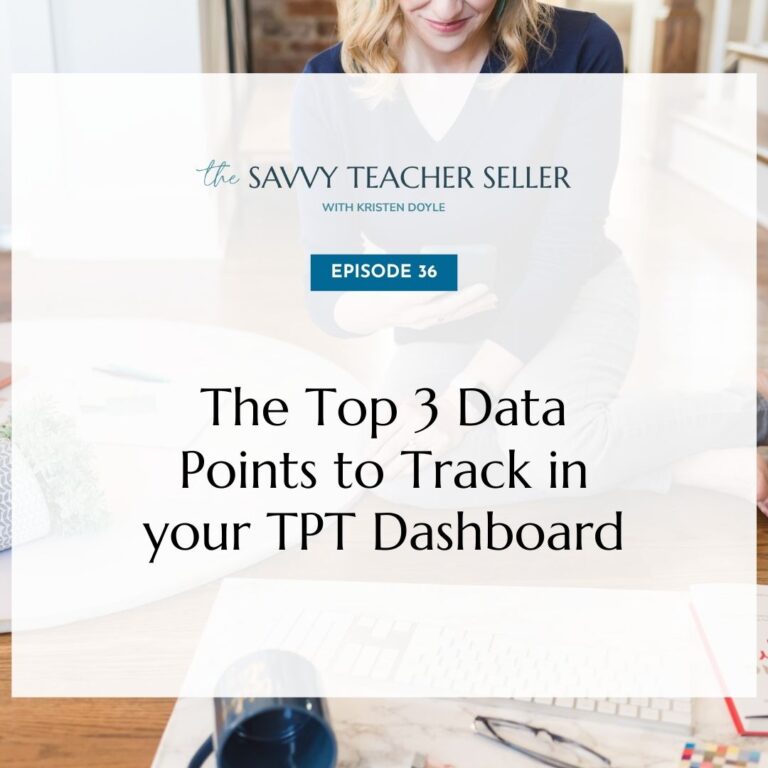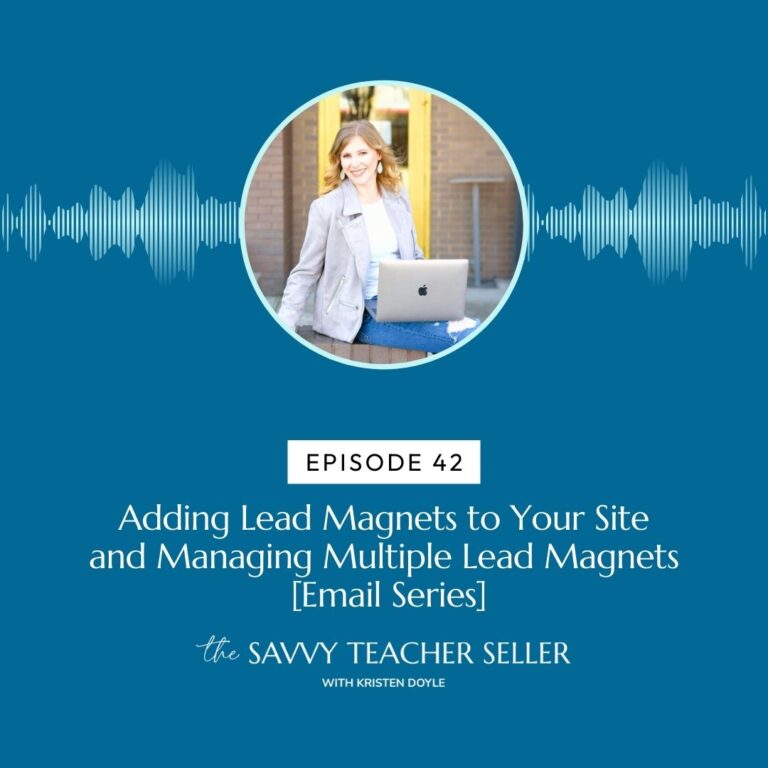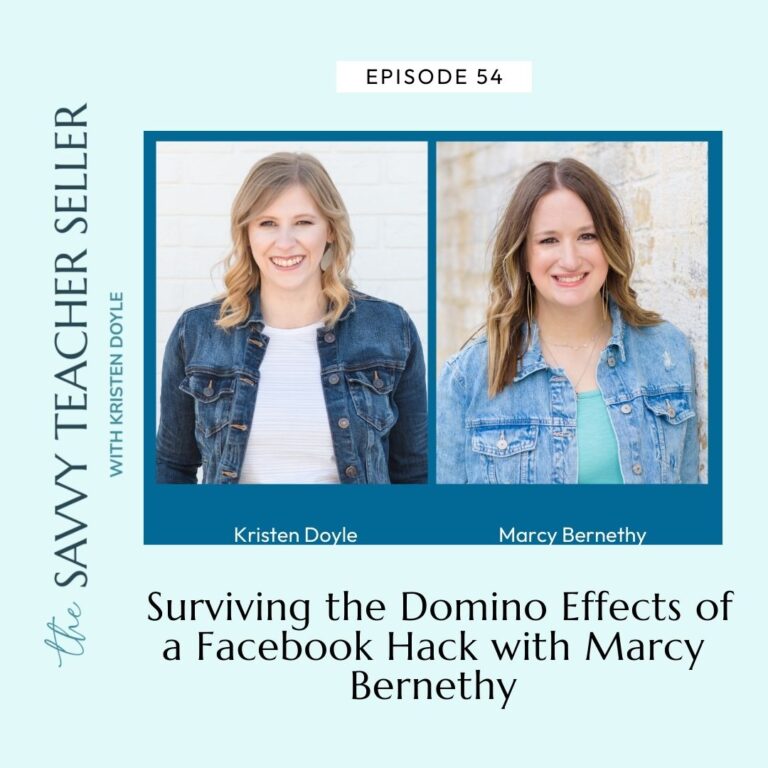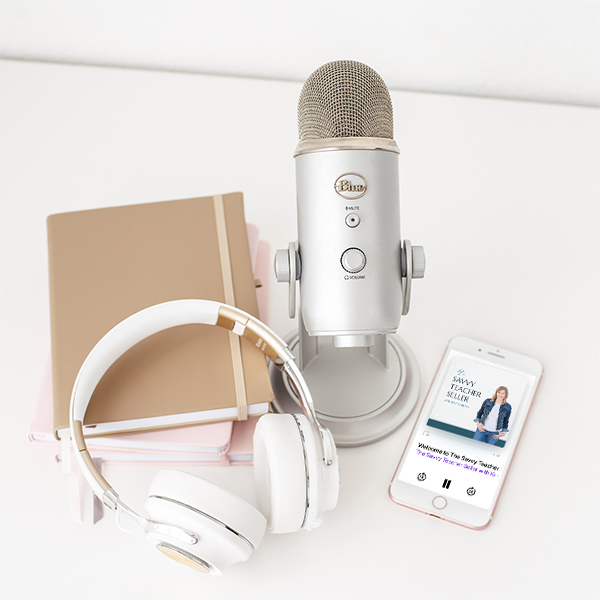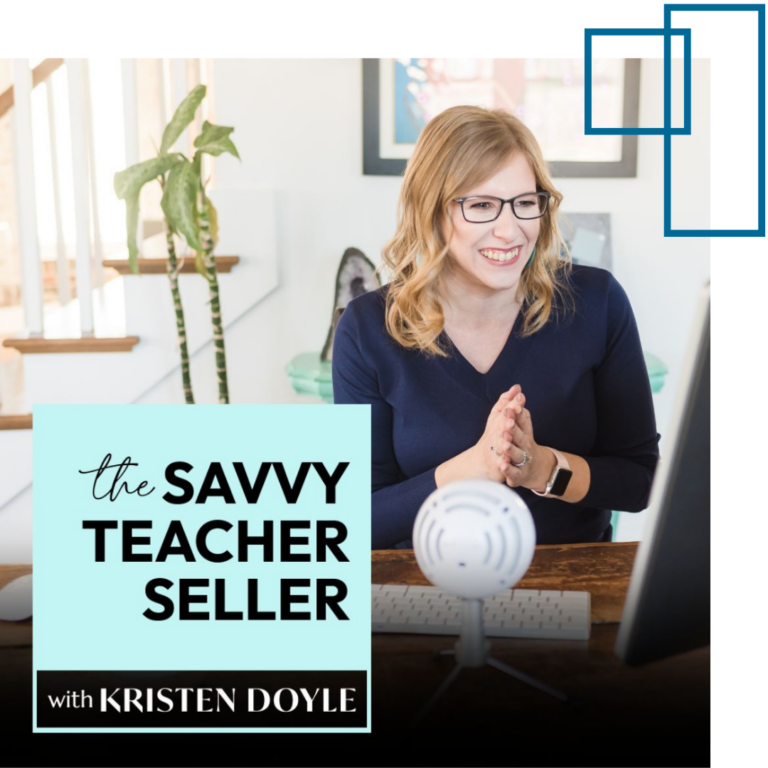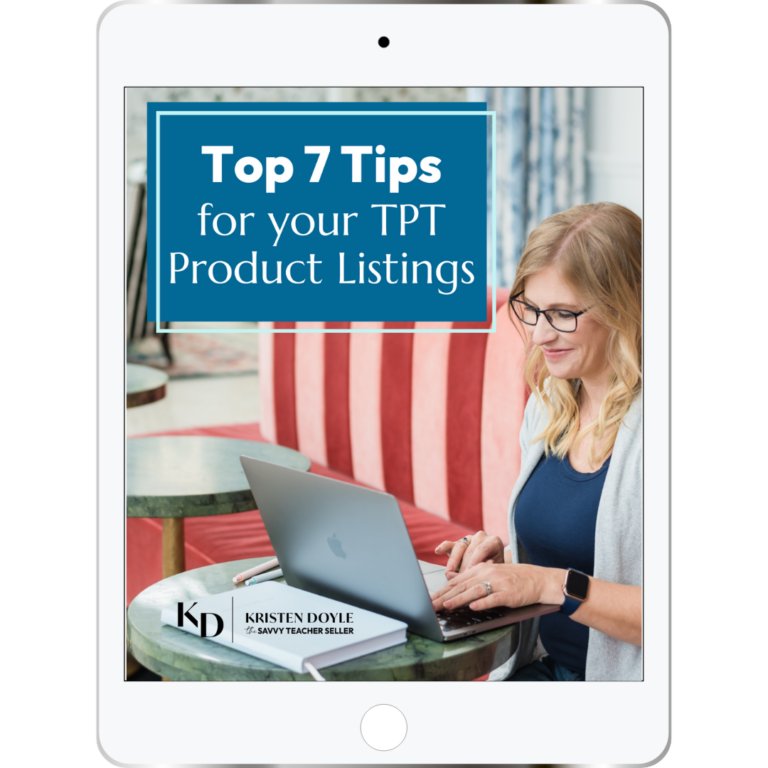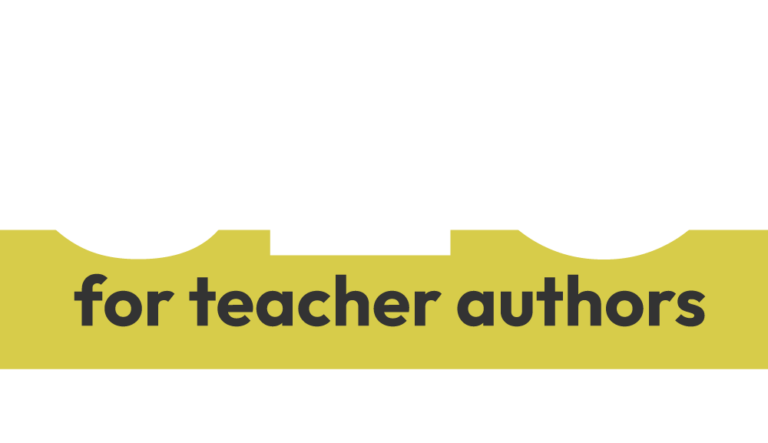Hey TPT sellers ready to seek growth in your business? You’re in the right place. Welcome to the savvy teacher seller. I’m Kristen Doyle. And I’m here to give you no fluff tools and strategies that will really make an impact on your sale. Let’s get started y’all.
Hey, y’all, if you have ever felt like you can’t afford something that you want to invest in for your business, or you struggled to make ends meet with your TPT income, and your teaching salary than today’s episode is for you.
When you think about your business finances, you probably think that you need to start with knowing how much to spend on ads or how much you should be paying yourself. But here’s the truth, you cannot invest in growing your business if you’re using all of the business income to pay your personal bills, so it is crucial to get your personal finances in order before tackling your business finances.
That’s why in today’s episode of the savvy teacher seller, we are starting our money series with getting your personal finances under control. I’ll cover everything from creating a budget to paying off debt and investing for the future. So let’s get right to it.
Like I shared earlier, it is vital that you get your personal finances in order before you started addressing your business finances. As teachers or former teachers, we know how tough it is to make ends meet on a teacher’s salary. And as TPT sellers, we all rely on our business income in one way or another, whether it’s to fully support our family or just as a supplement to our full time teaching salary.
Because TPT is such a seasonal industry, we have to be even more careful to make sure we’re not overspending during the high seasons, so that we have enough money for the things we need during the low seasons. And it really starts with getting your personal finances in order.
One of the first steps for that is to create and then live on a budget. And I know budgeting can be a dirty word for some people, it’s not something many of us like to talk about. But having a budget really helps you to understand how much you need to be saving during the high months. For me, that’s back to school season, so that you can still pay your bills, both personal and business in those lower leaner seasons.
Now, for me, that low season is around February to April every year. So I am just coming out of that low season. And because our family and my business run on a budget, we are okay. And we’re able to pay all of our bills, I’m able to pay for the memberships and subscriptions I have that run my business, pay my contractors who work with me. And it’s all because I operate everything based on a budget. And I’m going to explain to you kind of how that budget works.
So here are some tips for creating a budget that will allow you to also feel more relaxed and like you know that everything is going to be covered in those lower seasons.
First of all, start by tracking your income and your expenses. Go back over the last few months or even the last year if you have time. And look at what you are spending and what your income is overtime. This will give you a better understanding of where your money is going how much you have coming in. And it helps you to be realistic about your expenses and income so that you’re not over or under estimating as you create your budget.
Now let’s talk about my family’s budget. Obviously, everyone is going to need to create a budget that works for you. But this is what works for my family. We follow a give, save, spend model for our budget. So first, we give 10% to our local church and some more to a few charities that we really believe in and support. This comes off the top, it is non negotiable for our family. We do it first, and then we save at least 20%. And we have a budget that lets us live on the remaining 70% of our income.
Now this budget has been a lifesaver for us. And I really believe it can work for anyone. If you’re feeling like there’s currently no way that you could live on 70 or even 80% of your income. It might be time to take a look at your expenses and do some prioritizing there.
For us, one of the first things that we needed to do is get rid of subscriptions we weren’t really using. It is so easy these days to sign up for a new streaming service because you want to watch one show and then you forget to cancel it once the show ends. I know this is something that we have to revisit all the time those little subscriptions can really add up.
In fact, I saved our family $100 a month this past January, when I went back through our accounts again and got rid of some subscriptions we weren’t using. Spoiler: almost all of them were streaming memberships. And a couple of other things that we had been subscribed to and had stopped using.
Take a look at your apps that you are paying for in your app store, anything like that, that is an ongoing expense. If you’re not actively using it, get rid of it, it’s amazing how much you can save that way. Cleaning up our budget gave us the ability to start saving 20% of our income and that 20% savings initially helped us to build an emergency fund. Trust me, this is a non negotiable step, you never know when you’ll have an emergency expense pop up. And that emergency fund can also help you survive slow seasons on TPT.
So how much should you save, start by saving whatever you can, if you’ve managed to free up maybe $20 or $100 a month by eliminating some subscriptions, start by saving that. Every little bit helps. A good goal initially would be to save up to a six month emergency fund of how much you would need to spend and expenses, and then start working maybe a little slower toward a 12 month emergency fund.
In our family, my husband and I are both self employed. And so we feel like we need to have a full 12 month emergency fund just in case something were to happen. Because neither one of us have those consistent, reliable jobs that we feel like we can always fall back on. So we keep a little bit bigger emergency fund. And that may be something that you need to consider as well as a TPT seller, especially if you are full time on TPT.
Once you’ve built up a good emergency fund, it’s time to start paying off any debts that you have. See, every loan or credit card comes with interest. So the faster you can pay them off, the less you’re spending overall. And let me tell you from experience, it is incredible how much more money it feels like you have when you pay off those debts that have the biggest monthly payments.
We started personally with the highest interest rate debts first. But if you are just getting started with paying off debt, sometimes it is smart to work from smallest balance to largest balance. When you do this, you’ll pay off that first debt faster. And that gives you a real sense of satisfaction, and it makes you excited to continue paying off more debts.
In addition to that, paying off that first day gives you a little extra cash every month that you can put towards paying off the next loan, you might have heard that called a debt snowball strategy, and it really does work. So if you’re just getting started, and especially if your finances are tight right now, paying off that smallest debt first will help you to free up that extra cash every month.
Now, once you have paid off most of your debts, and for our family, we paid off all of the credit card debt. So we still at that point had car loans and a mortgage on our house. Once we paid off all of that revolving debt, we started investing in our future and that is kind of the next step that you want to get to.
Now, we continued after we started investing to pay off our vehicle loans as well. And now of course, we’re tackling the mortgage, that WOO is a long project for sure. But once you get to a manageable place with your debt, and your regular monthly finances, it’s time to start investing for the future.
Depending on where you are in life, that might mean retirement accounts, saving for kids college or any number of other things. And it’s important to invest because interest rates on our savings accounts are extremely low, you are not making very much money on those at all. So investing in higher yield accounts really is necessary if you want your money to grow over time.
This is where it’s important to talk to a financial planner who has your best interests at heart. Because investing for retirement is a complicated process. And there are so many questions and just things that we as average consumers may not understand about how it all works. So make sure that you talk to a good financial planner about the best options for you.
Investing for retirement or even saving for kids college might not be something that you’re thinking about right now, especially if you’re younger. But trust me, the sooner you start, the better off you’ll be in the long run.
Thank you so much for tuning into this episode of the savvy teacher seller. Today we talked about how important it is to manage your personal finances before diving into your business. Remember, you cannot invest in growing your business if you’re using all the income to pay your personal bills.
So your action step for today is to take a little time to evaluate your personal finances. And wherever you are right now, take the next step, whether that’s setting a budget and living by it, saving up an emergency fund or paying off some of your debts so that you can free up monthly cash flow.
By getting your personal finances in order you are going to set yourself up for financial success both personally and in your TPT business. So don’t wait to take those steps. Go ahead and get started this week. And make sure to join me for the next episode in this series, where I will dive into how to manage your business finances as well.
To make sure you don’t miss out on that episode, be sure to follow the show in your favorite podcast app. And while you’re there, leave us a rating and a review. I’ll talk to you soon.
I hope you enjoyed today’s episode. If you did, please share it with another teacher seller who would also find it helpful. For more resources on Growing Your TPT business. Head to Kristendoyle.co/TPT. Talk to you soon.

